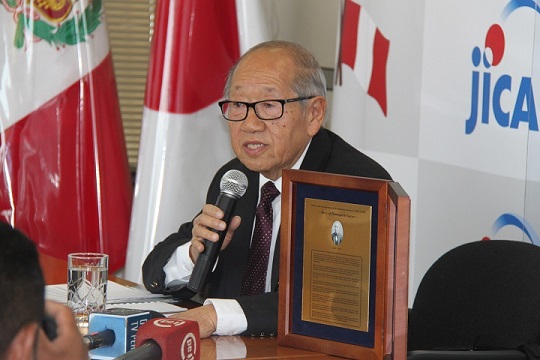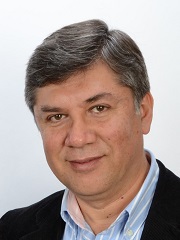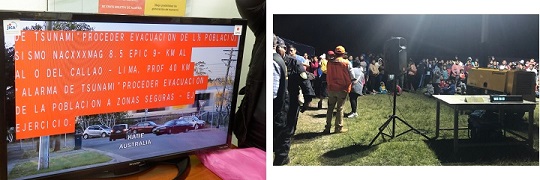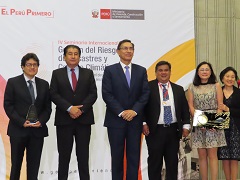- Home
- News & Features
- News
- FY2019
- “The god of earthquake research” and disaster prevention: a bond of cooperation that Professor Kuroiwa built between Peru and Japan
News
March 9, 2020
“The god of earthquake research” and disaster prevention: a bond of cooperation that Professor Kuroiwa built between Peru and Japan
Professor emeritus Julio Kuroiwa, Peru National University of Engineering, referred to as the “god of earthquakes” by Peruvian colleagues in the field of disaster prevention, passed away last year at the age of 83. Underlying admiration for his achievements that continues growing even after his death is a web of cooperation that Professor Kuroiwa wove between Peru and Japan in the field of cooperation for disaster prevention. Here we review the achievements of Professor Kuroiwa, an alumnus of JICA’s training programs, as well as the history of Japan-Peru cooperation in disaster prevention that spans more than half a century.
 Professor emeritus Julio Kuroiwa was a second-generation “Nikkei” (Peruvian of Japanese descent) born in Peru in 1936. He engaged in disaster prevention work such as earthquake and tsunami disaster mitigation research and consulting for over 50 years. He passed away in July 2019
Professor emeritus Julio Kuroiwa was a second-generation “Nikkei” (Peruvian of Japanese descent) born in Peru in 1936. He engaged in disaster prevention work such as earthquake and tsunami disaster mitigation research and consulting for over 50 years. He passed away in July 2019
Encountering JICA and laying the foundation for Japan-Peru cooperation on disaster prevention
In 1970, the Great Peruvian earthquake caused estimated 70,000 deaths in Ancash, a department of northern Peru, and neighboring areas. In the wake of the earthquake, Professor Kuroiwa was in charge of liaising with a survey team dispatched by Japan’s Overseas Technical Cooperation Agency, in support of regional recovery projects. Through that experience, he developed a strong sense of the need for earthquake disaster prevention research in Peru. So he began furthering such research after attending JICA training programs from 1975 to 1976 in Japan.
Speaking of that period, Miguel Estrada, a former Minister of Housing, Construction and Sanitation in Peru and student of Professor Kuroiwa, says:
 Speaking of his days as a student at the Peru National University of Engineering, Miguel Estrada says, “Professor Kuroiwa emphasized the importance of always focusing on the technical aspects of earthquake resistance during design and construction of infrastructure”
Speaking of his days as a student at the Peru National University of Engineering, Miguel Estrada says, “Professor Kuroiwa emphasized the importance of always focusing on the technical aspects of earthquake resistance during design and construction of infrastructure”
“Professor Kuroiwa studied earthquake engineering at Japan’s Building Research Institute from the 1960s, and he participated in JICA’s earthquake engineering training programs from 1975 to 1976. Following his return to Peru, he introduced the first course on earthquake engineering at Peru National University of Engineering, the top engineering university in the country. Later, he worked together with the late Roberto Morales, former rector of the Peru National University of Engineering, and other researchers at that university to promote the establishment of the Japan-Peru Center for Earthquake Engineering Research and Disaster Mitigation (CISMID) under the Japan-Peru Earthquake Disaster Mitigation Center Project, a technical cooperation project of JICA. He was appointed as the first director of that center later. Today, CISMID is a major center of earthquake disaster prevention not only in Peru, but throughout South America.”
Peru and its neighboring country, Chile, are both located along the Pacific rim seismic zone and have been affected by earthquakes and tsunami since early times. With varied natural environs and landforms that include mountains (sierras), tropical rain forests (selvas) and coastal areas (costas), Peru requires disaster prevention measures to protect against tsunami along its shore, as well as against urban structural collapses and landslides in the mountains.
“One of the few experts in Peru on the subject, the professor was interested in preparing against earthquakes and tsunami since the 1960s.” Praising Professor Kuroiwa’s foresight and dedicated research, Mr. Estrada added, “Following the 2011 Great East Japan Earthquake and Tsunami, he made repeated, forceful proposals regarding the danger of such phenomena and the importance of countermeasures through seminars given to the government and educational institutions.”
Utilization of Japanese Emergency Warning Broadcast System
From 2010 to 2015, JICA and the Japan Science and Technology Agency (JST) jointly conducted the “Peru Project for Enhancement of Earthquake and Tsunami Disaster Mitigation Technology in Peru.” Throughout the project, Professor Kuroiwa extended advice in the capacity of consultant, building bonds of cooperation between the nations for disaster prevention. On Nov. 5, 2016, “World Tsunami Awareness Day,” Peru conducted its first nation-wide tsunami evacuation drill using an emergency warning broadcast system (EWBS) based on digital terrestrial broadcasting equipment provided by Japan.
 Two scenes at the tsunami evacuation drill
Two scenes at the tsunami evacuation drill
(Left) Message delivered by emergency warning broadcast system (EWBS) scrolls across a screen
(Right) Residents evacuate based on EWBS information during night-time drill
Mr. Estrada says, “Professor Kuroiwa poured a lot of energy into developing his successors, and his teachings have been widely disseminated among regional government organizations where they are continuously put them into practice.” Mr. Estrada also expressed gratitude for Japan’s many years of cooperation, and especially for the support extended by JICA to the Peru National University of Engineering through the CISMID.
JICA President Award was conferred on Professor Kuroiwa
 Professor Kuroiwa’s family at the award ceremony with President Martín Vizcarra, one of the professor’s students (pictured center). The ceremony was widely reported, including by television broadcast and front-page coverage in major newspapers
Professor Kuroiwa’s family at the award ceremony with President Martín Vizcarra, one of the professor’s students (pictured center). The ceremony was widely reported, including by television broadcast and front-page coverage in major newspapers
Last year, Professor Kuroiwa was awarded the JICA President Award in recognition of his many great achievements. In a speech given at the award ceremony held last December in Peru, President Martín Vizcarra, also one of the professor’s students, said, “Professor Kuroiwa’s greatest achievement was to instill awareness of the need for unpredictable natural disasters at the local level.” Continuing in that spirit, he concluded his speech by saying, “we must continue our cooperation with the Peruvian people and their government, as well as JICA and other international organizations to further improve disaster preparedness measures.”
We will continue strengthening bonds of cooperation between Peru and Japan, building on the nucleus of the CISMID that was conceived and developed by Professor Kuroiwa.
Related Links
- About JICA
- News & Features
- Countries & Regions
- Our Work
- Thematic Issues
- Types of Assistance
- Partnerships with Other Development Partners
- Climate Change / Environmental and Social Considerations
- Evaluations
- Compliance and Anti-corruption
- Science and Technology Cooperation on Global Issues
- Research
- JICA Development Studies Program / JICA Chair
- Support for the Acceptance of Foreign HRs / Multicultural and Inclusive Community
- Publications
- Investor Relations





